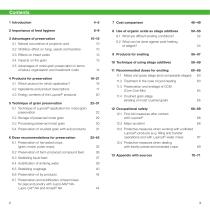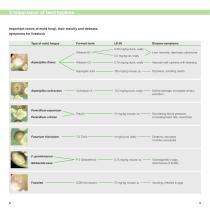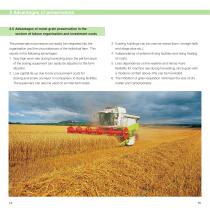
Catalog excerpts

North America BASF Corporation Animal Nutrition, North America 100 Park Avenue Florham Park, New Jersey 07932 USA Phone: +1-800-527-9889 Fax: +1-973-245-6766 E-mail: nutrition-north-america@basf.com Asia/Pacific BASF South East Asia Pte. Ltd. Animal Nutrition, Asia/Pacific 7 Temasek Boulevard, #35-01 038987 Singapore Singapore Phone: +65-6337-0330 Fax: +65-6432-3298 E-mail: nutrition-asia-pacific@basf.com Europe, Africa, West Asia BASF SE Animal Nutrition, Europe Chemiestraße 22 68623 Lampertheim Germany Phone: +49-621 60-28073 Fax: +49-621 60-28363 E-mail: nutrition-europe@basf.com South America BASF S.A. Animal Nutrition, South America Avenida das Nações Unidas 14.171 – 10th floor 04794-000 São Paulo SP Brazil Phone: +55-11-2039-2292 Fax: +55-11-2039-2344 E-mail: nutrition-south-america@basf.com Guide to Feed Preservation Solutions for Agricultural Operations This document, or any answers or information provided herein by BASF, does not constitute a legally binding obligation of BASF. While the descriptions, designs, data, and information contained herein are presented in good faith and believed to be accurate, it is provided for your guidance only. Because many factors may affect processing or application/use, we recommend that you make tests to determine the suitability of a product for your particular purpose prior to use. It does not relieve our customers from the obligation to perform a full inspection of the products upon delivery or any other obligation. No warranties of any kind, either express or implied, including warranties of merchantability or fitness for a particular purpose, are made regarding products described or designs, data, or information set forth, or that the products, designs, data, or information may be used without infringing the intellectual property rights of others. In no case shall the descriptions, information, data, or designs provided be considered a part of our terms and conditions of sale. (August 2016) Registered trademark of BASF in several countries. Trademark of BASF in several countries. Place orders, track shipments, get MSDSs and COAs, and more, with World Account, http://worldaccount.basf.com Published by BASF SE, Animal Nutrition, 67056 Ludwigshafen, Germany Note: National regulations may vary and need to be considered prior to product use.
Open the catalog to page 1
2 Importance of feed hygiene 8 Use of organic acids as silage additives 3.1 Natural occurrence of propionic acid 3.2 Inhibitory effect on fungi, yeasts and bacteria 3.3 Effects on insect pests 3.5 dvantages of moist grain preservation in terms A of labour organisation and investment costs 4.1 Which product for which application? 4.2 Ingredients and product descriptions 4.3 Energy contents of the Luprosil® products 5 echnique of grain preservation T 8.1 What are difficult ensiling conditions? 8.2 What can be done against post-heating of silages? 10 Technique of using silage additives 11...
Open the catalog to page 2
In times of low sales revenues from animal products, farm-pro- We also feature a number of additional duced feed becomes particularly important, as does its quality. products whose ratio of formic acid to propionic acid has been adapted to suit a wide Unpredictable weather patterns and heavy rainfall combined with variety of application areas. The products a more and more effective harvest chain constantly present new Lupro-Grain® and Luprosil® NC contain challenges to the harvest of feed such as hay or grain. buffered propionic acid. Lupro-Cid® NA and Lupro-Mix® NA contain additional...
Open the catalog to page 3
2 Importance of feed hygiene Feedstuffs such as grain, grain maize, pulse crops or even com- However, acid treatment to reduce the pound feed have a naturally high population of bacteria, mold microbe population and to improve the fungi and yeasts. Up to 6 million bacteria, 40,000 fungal micro- hygiene quality is worthwhile even at organisms and 50,000 yeasts are tolerated as an upper limit per lower moisture contents and is particularly gram of grain! The micro-organisms have an ideal substrate and recommended when feeding breeding under certain conditions can multiply very quickly. If a...
Open the catalog to page 4
2 Importance of feed hygiene Important toxins of mold fungi, their toxicity and desease symptoms for livestock Type of mold fungus Formed toxin Disease symptoms 0.36 mg/kg duck, orally Aflatoxin B1 Liver necrosis, diarrhoea, carcinoma 5.5 mg/kg rat, orally Aspergillus flavus 0.78 mg/kg duck, orally Vascular wall ruptures with bleeding Aspergillic acid Dizziness, vomiting, death 0.5 mg/kg duck, orally Kidney damage, increased urinary excretion Decreasing blood pressure, increasing heart rate, neurotoxic Oedema, decrease of white corpuscles Aspergillus ochraceus Vulvovaginitis in pigs,...
Open the catalog to page 5
3.1 Natural occurrence of propionic acid In addition to preservation in storage, it is particularly important in practical farming The main active ingredient of the BASF-preservation agent is pro- that acid treatment allows the production pionic acid, which occurs as an organic acid in nature. Propionic of low-microbe and hygienically safe feed acid is a building block in the metabolism of animals and plants. grain, which relieves the burden on the For instance, up to 1.5 litre propionic acid are formed daily by the immune system of the animals and has a rumen microbes of dairy cows and...
Open the catalog to page 6
Field fungi and store fungi are virtually completely killed off by 3.3 Effects on insect pests Luprosil® at the time of harvesting and reproduction of mold fungi during storage is suppressed. This successfully prevents the Grain weevil infestation in stored grain is a recurrent problem. The formation of mycotoxins from the time of harvesting onwards. damage caused by this known grain pest can be considerable. In However, mycotoxins which are formed up to the time of harvest- practice it has been demonstrated that after a Luprosil®-addition ing by field fungi (e. g. the fusariotoxins...
Open the catalog to page 7
3.5 Advantages of moist grain preservation in the sectors of labour organisation and investment costs The preservation procedure can easily be integrated into the organisation and the circumstances of the individual farm. This results in the following advantages: 1. Very high work rate during harvesting since the performance of the dosing equipment can easily be adjusted to the farm situation. 2. Low capital tie-up due to low procurement costs for dosing and screw conveyor in comparison to drying facilities. The equipment can also be used on an inter-farm basis. 3. Existing buildings can be...
Open the catalog to page 8All Nutrition.basf catalogs and technical brochures
-
Natupulse® TS
7 Pages
-
Natuphos® E 5000 Combi
5 Pages
-
Lucantin® Red
12 Pages
-
BalanGut® AQ
2 Pages
-
BalanGut® LS
2 Pages
-
Natuphos® E
11 Pages
-
Natuphos® 5000
11 Pages
-
Natugrain® TS 5XG
11 Pages
-
Natugrain® TS DL
11 Pages













